An Analysis of Evidence-Based Practice in Healthcare and Social Care
VerifiedAdded on 2020/12/09
|7
|2066
|118
Report
AI Summary
This report examines the fundamentals of evidence-based practice (EBP) in healthcare and social care. It begins by outlining the purpose and process of conducting research to enable EBP, emphasizing its role in improving patient outcomes and enhancing individual skills. The report then details the essential skills and qualities required for conducting literature reviews, focusing on communication, computer literacy, and ongoing learning. The Gibbs reflection model is explained, including its stages of description, feeling, evaluation, conclusion, and action, and how it applies to healthcare research. Additionally, the report covers the use of milestone plans and work breakdown structures (WBS) to decompose major tasks and ensure thorough project planning, with the aim of clearly defining outcomes and managing project activities. The report concludes by summarizing the importance of communication skills, the application of evidence-based practices, and the significance of research in healthcare for patient satisfaction and improved outcomes. The report references various books and journals to support its findings.
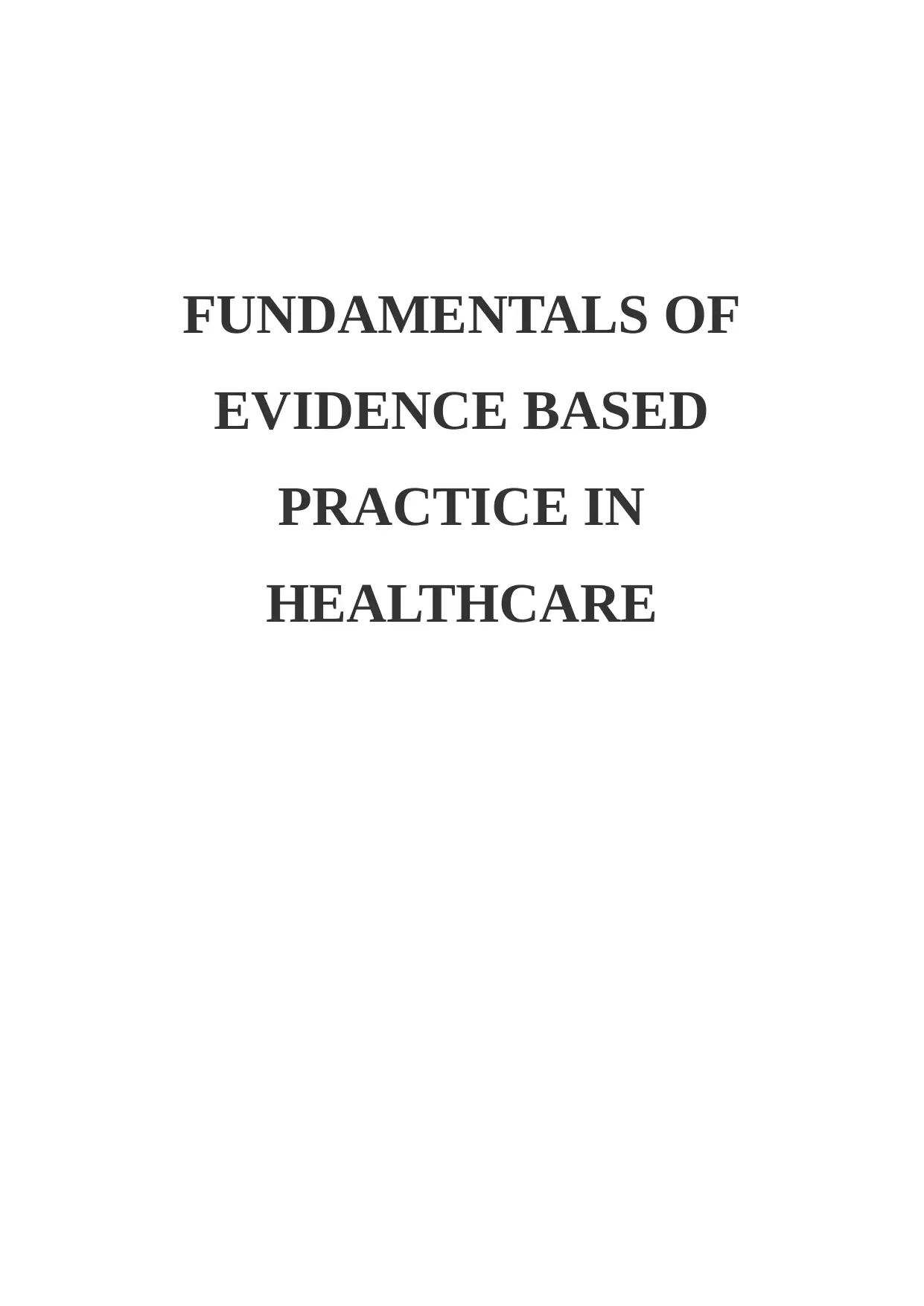
FUNDAMENTALS OF
EVIDENCE BASED
PRACTICE IN
HEALTHCARE
EVIDENCE BASED
PRACTICE IN
HEALTHCARE
Paraphrase This Document
Need a fresh take? Get an instant paraphrase of this document with our AI Paraphraser
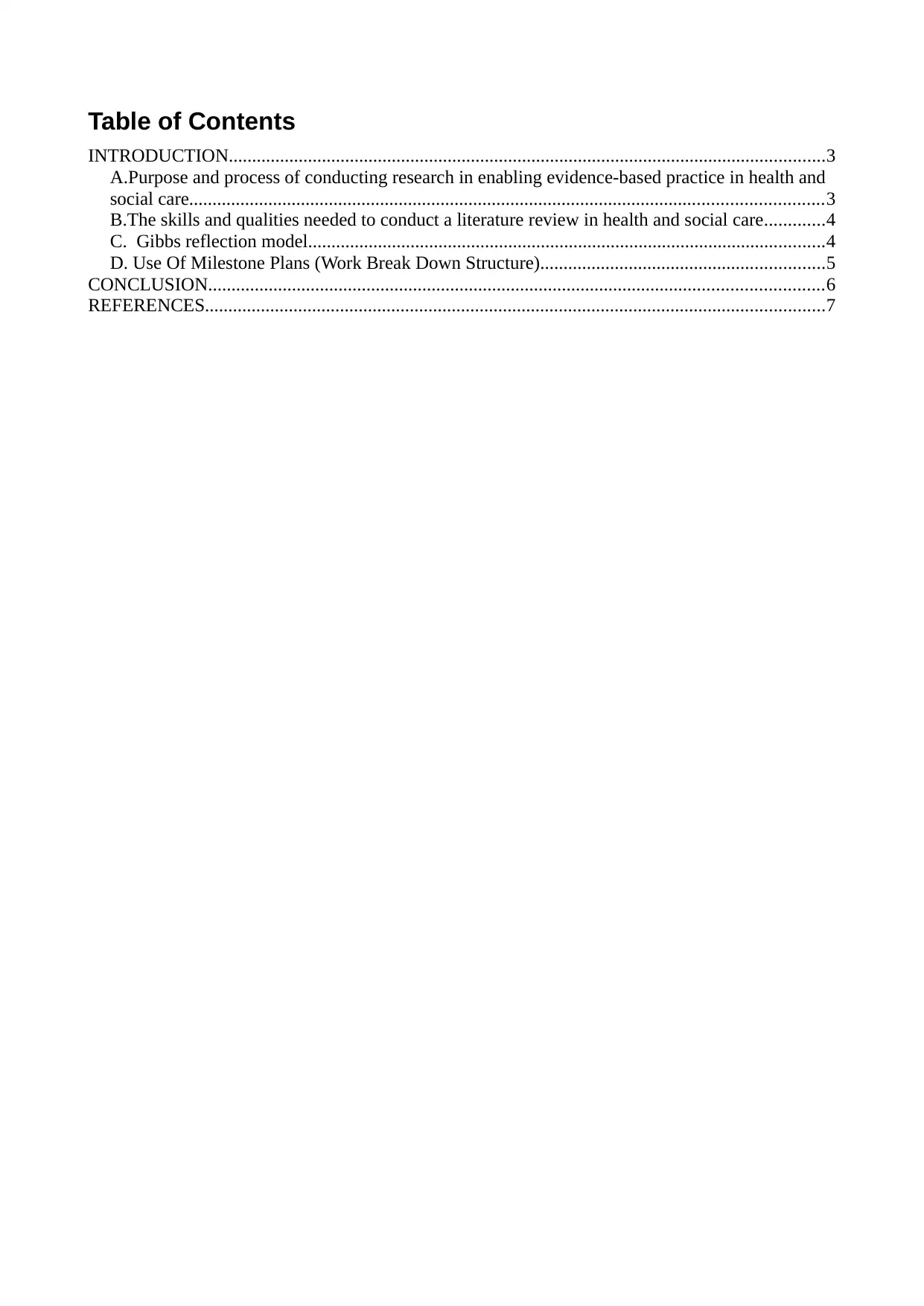
Table of Contents
INTRODUCTION................................................................................................................................3
A.Purpose and process of conducting research in enabling evidence-based practice in health and
social care........................................................................................................................................3
B.The skills and qualities needed to conduct a literature review in health and social care.............4
C. Gibbs reflection model...............................................................................................................4
D. Use Of Milestone Plans (Work Break Down Structure).............................................................5
CONCLUSION....................................................................................................................................6
REFERENCES.....................................................................................................................................7
INTRODUCTION................................................................................................................................3
A.Purpose and process of conducting research in enabling evidence-based practice in health and
social care........................................................................................................................................3
B.The skills and qualities needed to conduct a literature review in health and social care.............4
C. Gibbs reflection model...............................................................................................................4
D. Use Of Milestone Plans (Work Break Down Structure).............................................................5
CONCLUSION....................................................................................................................................6
REFERENCES.....................................................................................................................................7
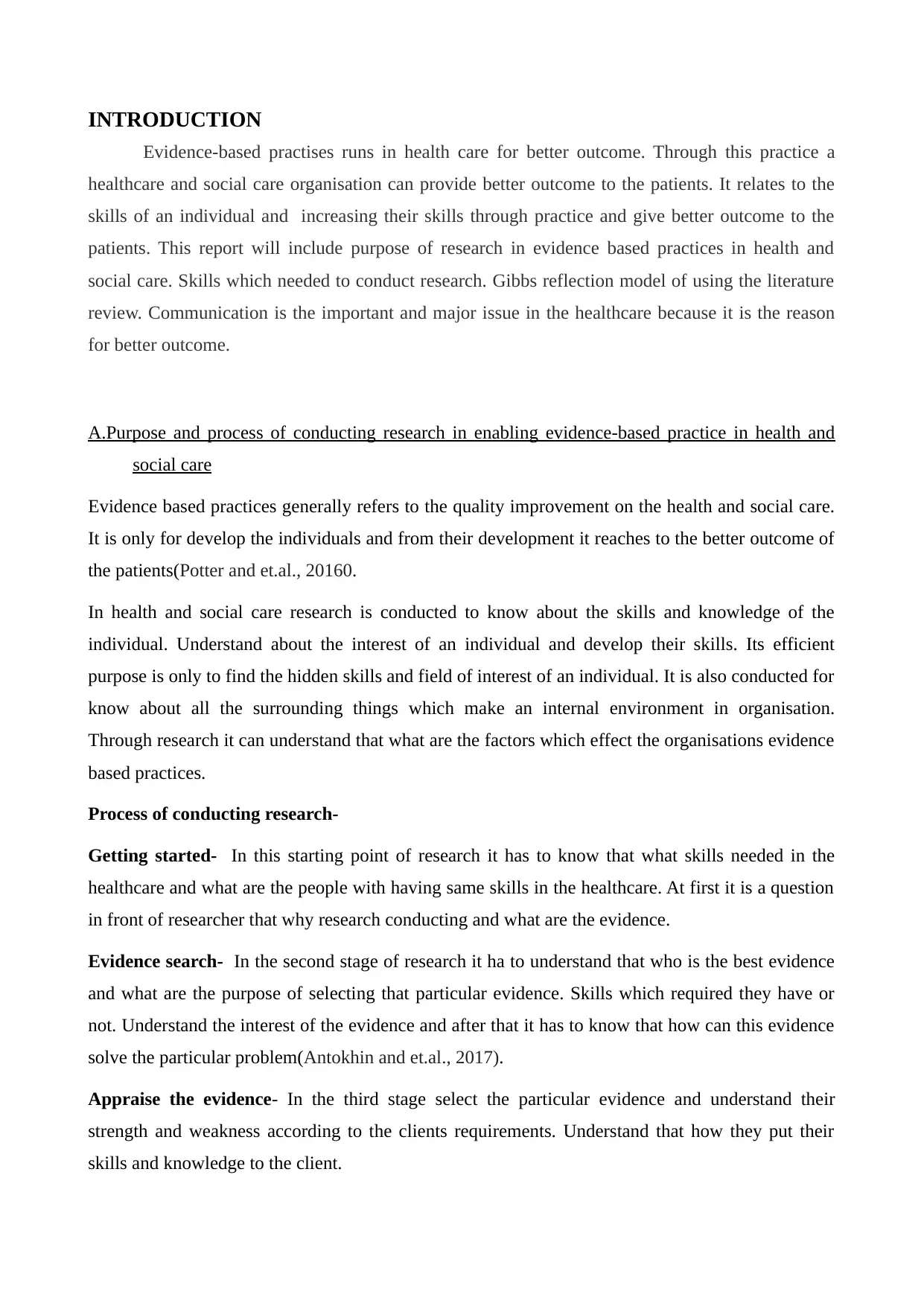
INTRODUCTION
Evidence-based practises runs in health care for better outcome. Through this practice a
healthcare and social care organisation can provide better outcome to the patients. It relates to the
skills of an individual and increasing their skills through practice and give better outcome to the
patients. This report will include purpose of research in evidence based practices in health and
social care. Skills which needed to conduct research. Gibbs reflection model of using the literature
review. Communication is the important and major issue in the healthcare because it is the reason
for better outcome.
A.Purpose and process of conducting research in enabling evidence-based practice in health and
social care
Evidence based practices generally refers to the quality improvement on the health and social care.
It is only for develop the individuals and from their development it reaches to the better outcome of
the patients(Potter and et.al., 20160.
In health and social care research is conducted to know about the skills and knowledge of the
individual. Understand about the interest of an individual and develop their skills. Its efficient
purpose is only to find the hidden skills and field of interest of an individual. It is also conducted for
know about all the surrounding things which make an internal environment in organisation.
Through research it can understand that what are the factors which effect the organisations evidence
based practices.
Process of conducting research-
Getting started- In this starting point of research it has to know that what skills needed in the
healthcare and what are the people with having same skills in the healthcare. At first it is a question
in front of researcher that why research conducting and what are the evidence.
Evidence search- In the second stage of research it ha to understand that who is the best evidence
and what are the purpose of selecting that particular evidence. Skills which required they have or
not. Understand the interest of the evidence and after that it has to know that how can this evidence
solve the particular problem(Antokhin and et.al., 2017).
Appraise the evidence- In the third stage select the particular evidence and understand their
strength and weakness according to the clients requirements. Understand that how they put their
skills and knowledge to the client.
Evidence-based practises runs in health care for better outcome. Through this practice a
healthcare and social care organisation can provide better outcome to the patients. It relates to the
skills of an individual and increasing their skills through practice and give better outcome to the
patients. This report will include purpose of research in evidence based practices in health and
social care. Skills which needed to conduct research. Gibbs reflection model of using the literature
review. Communication is the important and major issue in the healthcare because it is the reason
for better outcome.
A.Purpose and process of conducting research in enabling evidence-based practice in health and
social care
Evidence based practices generally refers to the quality improvement on the health and social care.
It is only for develop the individuals and from their development it reaches to the better outcome of
the patients(Potter and et.al., 20160.
In health and social care research is conducted to know about the skills and knowledge of the
individual. Understand about the interest of an individual and develop their skills. Its efficient
purpose is only to find the hidden skills and field of interest of an individual. It is also conducted for
know about all the surrounding things which make an internal environment in organisation.
Through research it can understand that what are the factors which effect the organisations evidence
based practices.
Process of conducting research-
Getting started- In this starting point of research it has to know that what skills needed in the
healthcare and what are the people with having same skills in the healthcare. At first it is a question
in front of researcher that why research conducting and what are the evidence.
Evidence search- In the second stage of research it ha to understand that who is the best evidence
and what are the purpose of selecting that particular evidence. Skills which required they have or
not. Understand the interest of the evidence and after that it has to know that how can this evidence
solve the particular problem(Antokhin and et.al., 2017).
Appraise the evidence- In the third stage select the particular evidence and understand their
strength and weakness according to the clients requirements. Understand that how they put their
skills and knowledge to the client.
⊘ This is a preview!⊘
Do you want full access?
Subscribe today to unlock all pages.

Trusted by 1+ million students worldwide
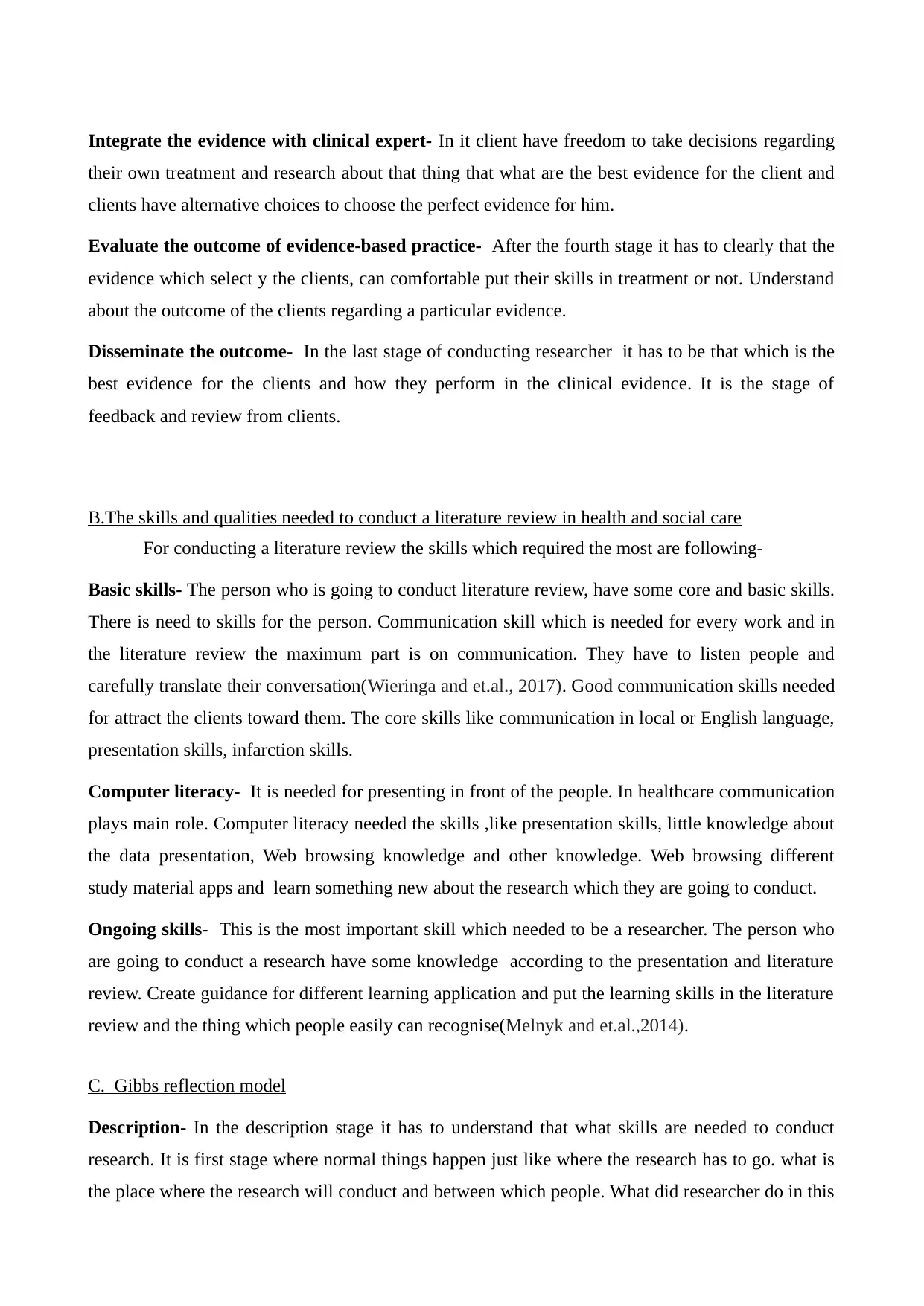
Integrate the evidence with clinical expert- In it client have freedom to take decisions regarding
their own treatment and research about that thing that what are the best evidence for the client and
clients have alternative choices to choose the perfect evidence for him.
Evaluate the outcome of evidence-based practice- After the fourth stage it has to clearly that the
evidence which select y the clients, can comfortable put their skills in treatment or not. Understand
about the outcome of the clients regarding a particular evidence.
Disseminate the outcome- In the last stage of conducting researcher it has to be that which is the
best evidence for the clients and how they perform in the clinical evidence. It is the stage of
feedback and review from clients.
B.The skills and qualities needed to conduct a literature review in health and social care
For conducting a literature review the skills which required the most are following-
Basic skills- The person who is going to conduct literature review, have some core and basic skills.
There is need to skills for the person. Communication skill which is needed for every work and in
the literature review the maximum part is on communication. They have to listen people and
carefully translate their conversation(Wieringa and et.al., 2017). Good communication skills needed
for attract the clients toward them. The core skills like communication in local or English language,
presentation skills, infarction skills.
Computer literacy- It is needed for presenting in front of the people. In healthcare communication
plays main role. Computer literacy needed the skills ,like presentation skills, little knowledge about
the data presentation, Web browsing knowledge and other knowledge. Web browsing different
study material apps and learn something new about the research which they are going to conduct.
Ongoing skills- This is the most important skill which needed to be a researcher. The person who
are going to conduct a research have some knowledge according to the presentation and literature
review. Create guidance for different learning application and put the learning skills in the literature
review and the thing which people easily can recognise(Melnyk and et.al.,2014).
C. Gibbs reflection model
Description- In the description stage it has to understand that what skills are needed to conduct
research. It is first stage where normal things happen just like where the research has to go. what is
the place where the research will conduct and between which people. What did researcher do in this
their own treatment and research about that thing that what are the best evidence for the client and
clients have alternative choices to choose the perfect evidence for him.
Evaluate the outcome of evidence-based practice- After the fourth stage it has to clearly that the
evidence which select y the clients, can comfortable put their skills in treatment or not. Understand
about the outcome of the clients regarding a particular evidence.
Disseminate the outcome- In the last stage of conducting researcher it has to be that which is the
best evidence for the clients and how they perform in the clinical evidence. It is the stage of
feedback and review from clients.
B.The skills and qualities needed to conduct a literature review in health and social care
For conducting a literature review the skills which required the most are following-
Basic skills- The person who is going to conduct literature review, have some core and basic skills.
There is need to skills for the person. Communication skill which is needed for every work and in
the literature review the maximum part is on communication. They have to listen people and
carefully translate their conversation(Wieringa and et.al., 2017). Good communication skills needed
for attract the clients toward them. The core skills like communication in local or English language,
presentation skills, infarction skills.
Computer literacy- It is needed for presenting in front of the people. In healthcare communication
plays main role. Computer literacy needed the skills ,like presentation skills, little knowledge about
the data presentation, Web browsing knowledge and other knowledge. Web browsing different
study material apps and learn something new about the research which they are going to conduct.
Ongoing skills- This is the most important skill which needed to be a researcher. The person who
are going to conduct a research have some knowledge according to the presentation and literature
review. Create guidance for different learning application and put the learning skills in the literature
review and the thing which people easily can recognise(Melnyk and et.al.,2014).
C. Gibbs reflection model
Description- In the description stage it has to understand that what skills are needed to conduct
research. It is first stage where normal things happen just like where the research has to go. what is
the place where the research will conduct and between which people. What did researcher do in this
Paraphrase This Document
Need a fresh take? Get an instant paraphrase of this document with our AI Paraphraser
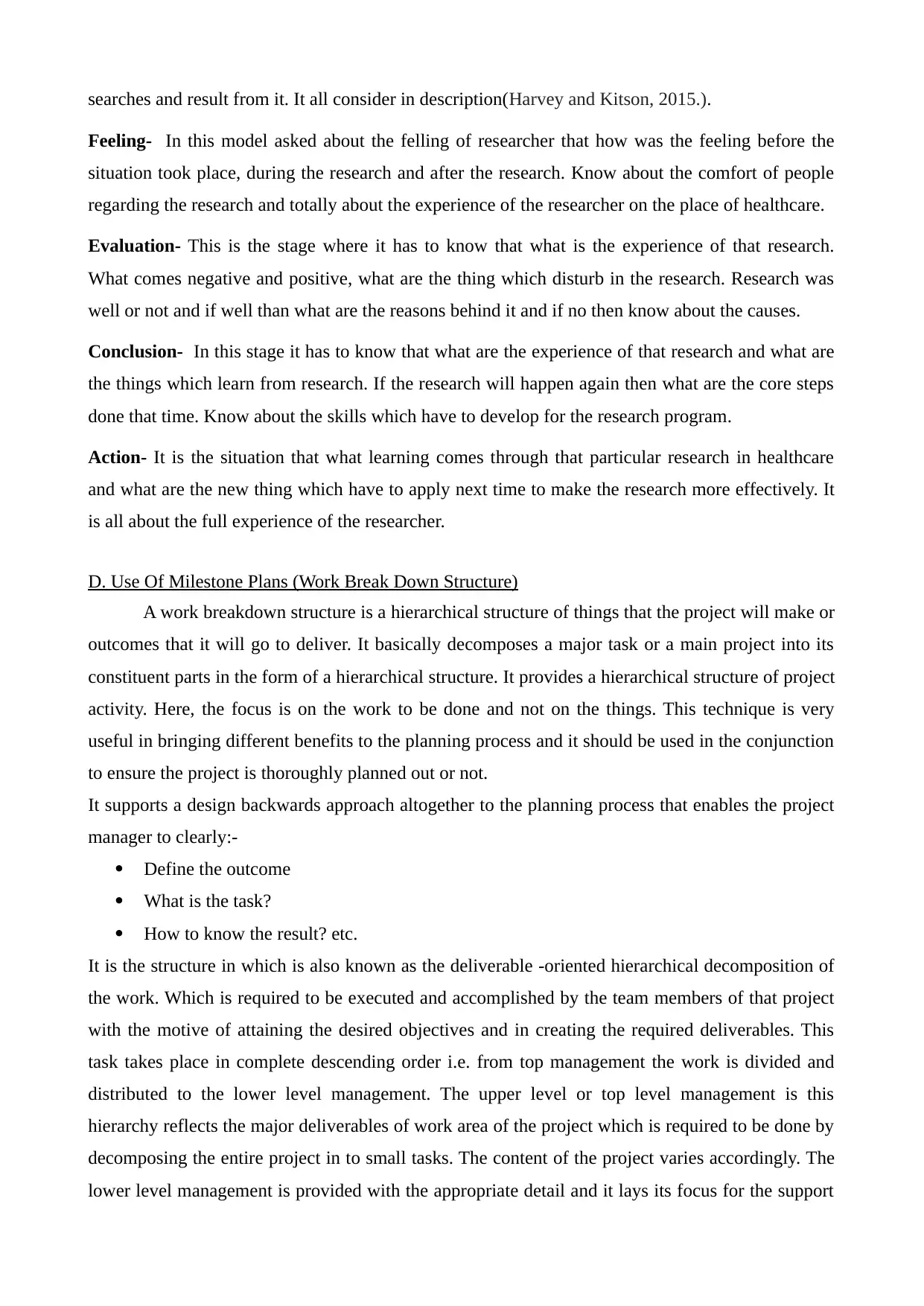
searches and result from it. It all consider in description(Harvey and Kitson, 2015.).
Feeling- In this model asked about the felling of researcher that how was the feeling before the
situation took place, during the research and after the research. Know about the comfort of people
regarding the research and totally about the experience of the researcher on the place of healthcare.
Evaluation- This is the stage where it has to know that what is the experience of that research.
What comes negative and positive, what are the thing which disturb in the research. Research was
well or not and if well than what are the reasons behind it and if no then know about the causes.
Conclusion- In this stage it has to know that what are the experience of that research and what are
the things which learn from research. If the research will happen again then what are the core steps
done that time. Know about the skills which have to develop for the research program.
Action- It is the situation that what learning comes through that particular research in healthcare
and what are the new thing which have to apply next time to make the research more effectively. It
is all about the full experience of the researcher.
D. Use Of Milestone Plans (Work Break Down Structure)
A work breakdown structure is a hierarchical structure of things that the project will make or
outcomes that it will go to deliver. It basically decomposes a major task or a main project into its
constituent parts in the form of a hierarchical structure. It provides a hierarchical structure of project
activity. Here, the focus is on the work to be done and not on the things. This technique is very
useful in bringing different benefits to the planning process and it should be used in the conjunction
to ensure the project is thoroughly planned out or not.
It supports a design backwards approach altogether to the planning process that enables the project
manager to clearly:-
Define the outcome
What is the task?
How to know the result? etc.
It is the structure in which is also known as the deliverable -oriented hierarchical decomposition of
the work. Which is required to be executed and accomplished by the team members of that project
with the motive of attaining the desired objectives and in creating the required deliverables. This
task takes place in complete descending order i.e. from top management the work is divided and
distributed to the lower level management. The upper level or top level management is this
hierarchy reflects the major deliverables of work area of the project which is required to be done by
decomposing the entire project in to small tasks. The content of the project varies accordingly. The
lower level management is provided with the appropriate detail and it lays its focus for the support
Feeling- In this model asked about the felling of researcher that how was the feeling before the
situation took place, during the research and after the research. Know about the comfort of people
regarding the research and totally about the experience of the researcher on the place of healthcare.
Evaluation- This is the stage where it has to know that what is the experience of that research.
What comes negative and positive, what are the thing which disturb in the research. Research was
well or not and if well than what are the reasons behind it and if no then know about the causes.
Conclusion- In this stage it has to know that what are the experience of that research and what are
the things which learn from research. If the research will happen again then what are the core steps
done that time. Know about the skills which have to develop for the research program.
Action- It is the situation that what learning comes through that particular research in healthcare
and what are the new thing which have to apply next time to make the research more effectively. It
is all about the full experience of the researcher.
D. Use Of Milestone Plans (Work Break Down Structure)
A work breakdown structure is a hierarchical structure of things that the project will make or
outcomes that it will go to deliver. It basically decomposes a major task or a main project into its
constituent parts in the form of a hierarchical structure. It provides a hierarchical structure of project
activity. Here, the focus is on the work to be done and not on the things. This technique is very
useful in bringing different benefits to the planning process and it should be used in the conjunction
to ensure the project is thoroughly planned out or not.
It supports a design backwards approach altogether to the planning process that enables the project
manager to clearly:-
Define the outcome
What is the task?
How to know the result? etc.
It is the structure in which is also known as the deliverable -oriented hierarchical decomposition of
the work. Which is required to be executed and accomplished by the team members of that project
with the motive of attaining the desired objectives and in creating the required deliverables. This
task takes place in complete descending order i.e. from top management the work is divided and
distributed to the lower level management. The upper level or top level management is this
hierarchy reflects the major deliverables of work area of the project which is required to be done by
decomposing the entire project in to small tasks. The content of the project varies accordingly. The
lower level management is provided with the appropriate detail and it lays its focus for the support
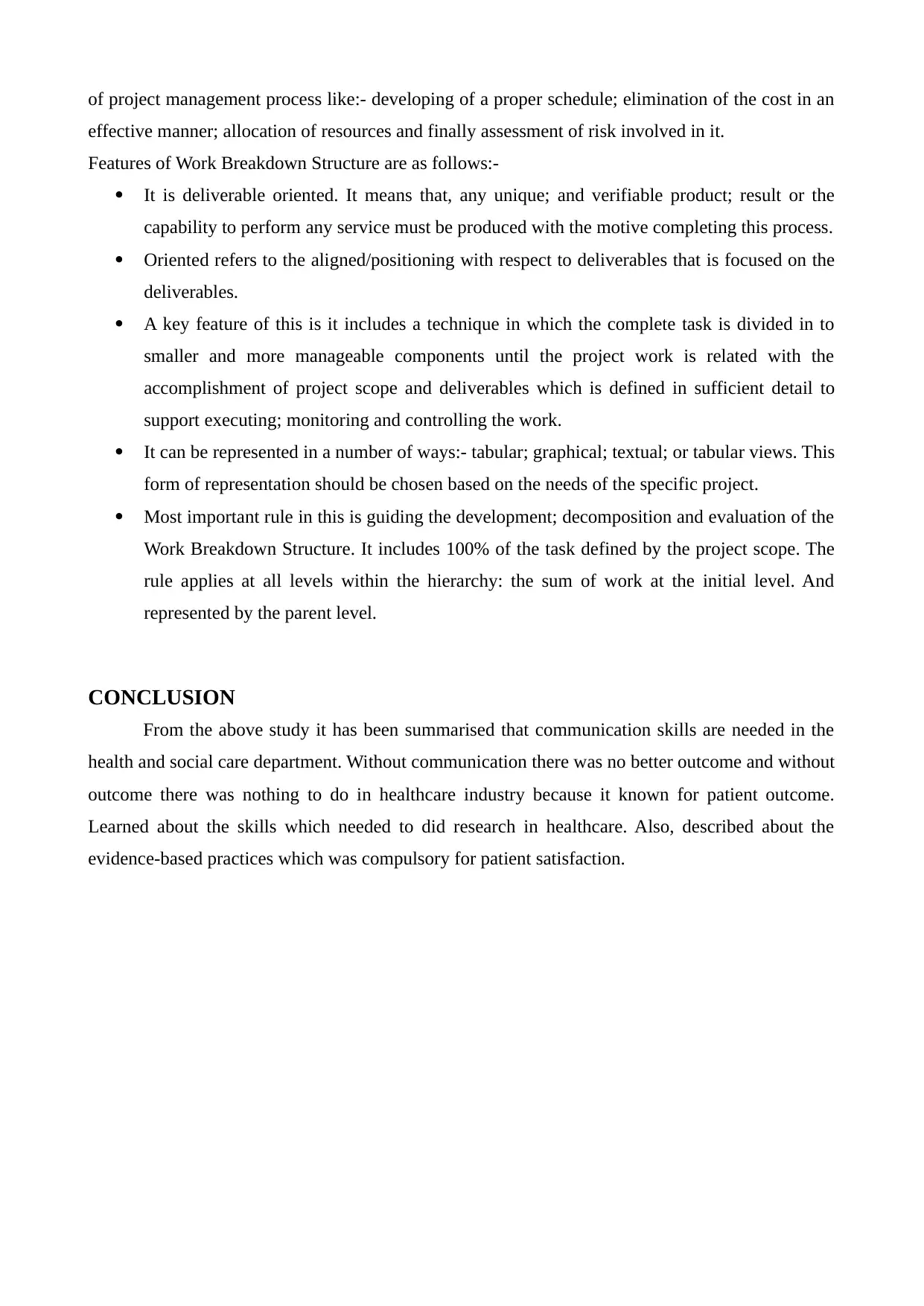
of project management process like:- developing of a proper schedule; elimination of the cost in an
effective manner; allocation of resources and finally assessment of risk involved in it.
Features of Work Breakdown Structure are as follows:-
It is deliverable oriented. It means that, any unique; and verifiable product; result or the
capability to perform any service must be produced with the motive completing this process.
Oriented refers to the aligned/positioning with respect to deliverables that is focused on the
deliverables.
A key feature of this is it includes a technique in which the complete task is divided in to
smaller and more manageable components until the project work is related with the
accomplishment of project scope and deliverables which is defined in sufficient detail to
support executing; monitoring and controlling the work.
It can be represented in a number of ways:- tabular; graphical; textual; or tabular views. This
form of representation should be chosen based on the needs of the specific project.
Most important rule in this is guiding the development; decomposition and evaluation of the
Work Breakdown Structure. It includes 100% of the task defined by the project scope. The
rule applies at all levels within the hierarchy: the sum of work at the initial level. And
represented by the parent level.
CONCLUSION
From the above study it has been summarised that communication skills are needed in the
health and social care department. Without communication there was no better outcome and without
outcome there was nothing to do in healthcare industry because it known for patient outcome.
Learned about the skills which needed to did research in healthcare. Also, described about the
evidence-based practices which was compulsory for patient satisfaction.
effective manner; allocation of resources and finally assessment of risk involved in it.
Features of Work Breakdown Structure are as follows:-
It is deliverable oriented. It means that, any unique; and verifiable product; result or the
capability to perform any service must be produced with the motive completing this process.
Oriented refers to the aligned/positioning with respect to deliverables that is focused on the
deliverables.
A key feature of this is it includes a technique in which the complete task is divided in to
smaller and more manageable components until the project work is related with the
accomplishment of project scope and deliverables which is defined in sufficient detail to
support executing; monitoring and controlling the work.
It can be represented in a number of ways:- tabular; graphical; textual; or tabular views. This
form of representation should be chosen based on the needs of the specific project.
Most important rule in this is guiding the development; decomposition and evaluation of the
Work Breakdown Structure. It includes 100% of the task defined by the project scope. The
rule applies at all levels within the hierarchy: the sum of work at the initial level. And
represented by the parent level.
CONCLUSION
From the above study it has been summarised that communication skills are needed in the
health and social care department. Without communication there was no better outcome and without
outcome there was nothing to do in healthcare industry because it known for patient outcome.
Learned about the skills which needed to did research in healthcare. Also, described about the
evidence-based practices which was compulsory for patient satisfaction.
⊘ This is a preview!⊘
Do you want full access?
Subscribe today to unlock all pages.

Trusted by 1+ million students worldwide
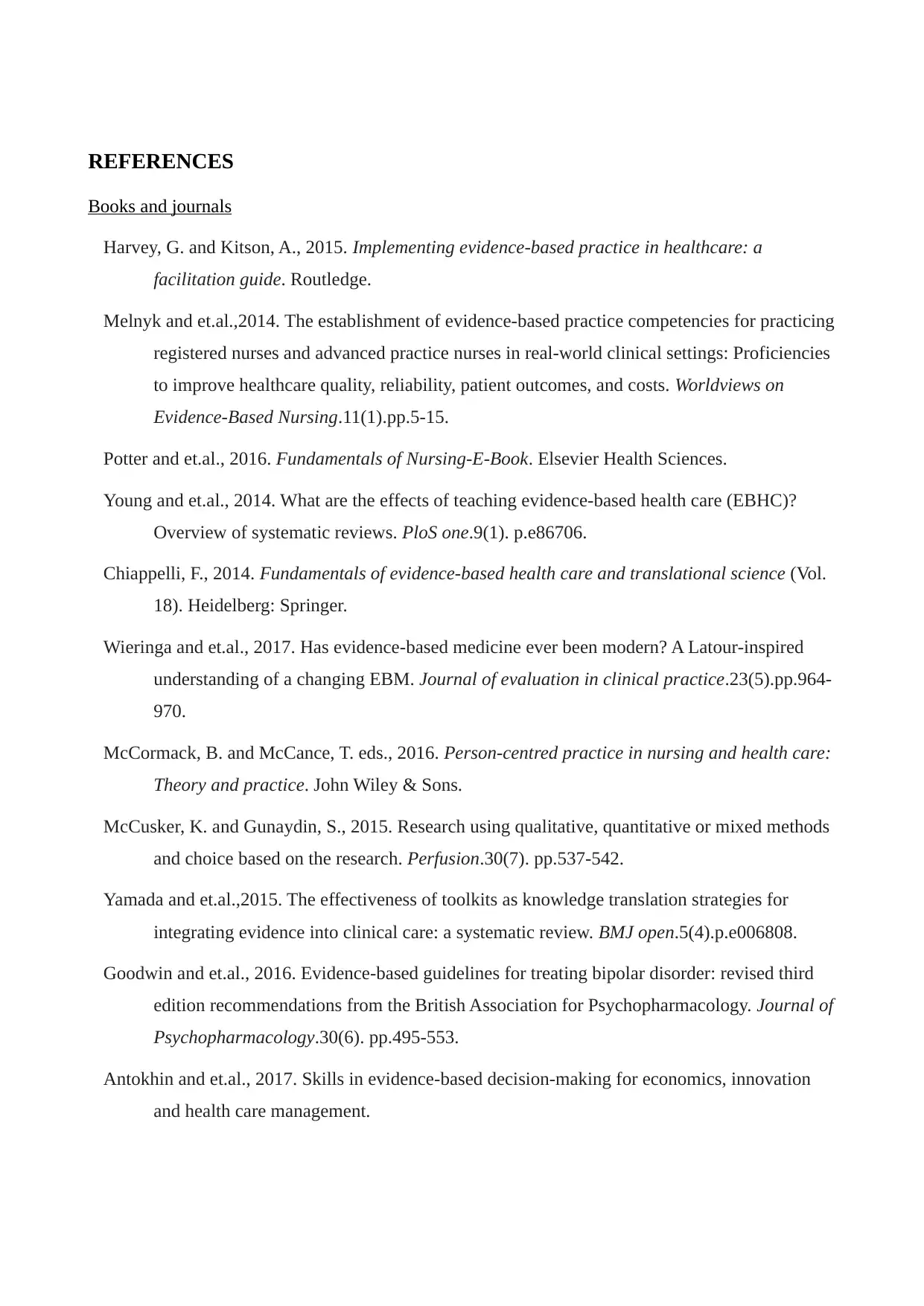
REFERENCES
Books and journals
Harvey, G. and Kitson, A., 2015. Implementing evidence-based practice in healthcare: a
facilitation guide. Routledge.
Melnyk and et.al.,2014. The establishment of evidence‐based practice competencies for practicing
registered nurses and advanced practice nurses in real‐world clinical settings: Proficiencies
to improve healthcare quality, reliability, patient outcomes, and costs. Worldviews on
Evidence‐Based Nursing.11(1).pp.5-15.
Potter and et.al., 2016. Fundamentals of Nursing-E-Book. Elsevier Health Sciences.
Young and et.al., 2014. What are the effects of teaching evidence-based health care (EBHC)?
Overview of systematic reviews. PloS one.9(1). p.e86706.
Chiappelli, F., 2014. Fundamentals of evidence-based health care and translational science (Vol.
18). Heidelberg: Springer.
Wieringa and et.al., 2017. Has evidence‐based medicine ever been modern? A Latour‐inspired
understanding of a changing EBM. Journal of evaluation in clinical practice.23(5).pp.964-
970.
McCormack, B. and McCance, T. eds., 2016. Person-centred practice in nursing and health care:
Theory and practice. John Wiley & Sons.
McCusker, K. and Gunaydin, S., 2015. Research using qualitative, quantitative or mixed methods
and choice based on the research. Perfusion.30(7). pp.537-542.
Yamada and et.al.,2015. The effectiveness of toolkits as knowledge translation strategies for
integrating evidence into clinical care: a systematic review. BMJ open.5(4).p.e006808.
Goodwin and et.al., 2016. Evidence-based guidelines for treating bipolar disorder: revised third
edition recommendations from the British Association for Psychopharmacology. Journal of
Psychopharmacology.30(6). pp.495-553.
Antokhin and et.al., 2017. Skills in evidence-based decision-making for economics, innovation
and health care management.
Books and journals
Harvey, G. and Kitson, A., 2015. Implementing evidence-based practice in healthcare: a
facilitation guide. Routledge.
Melnyk and et.al.,2014. The establishment of evidence‐based practice competencies for practicing
registered nurses and advanced practice nurses in real‐world clinical settings: Proficiencies
to improve healthcare quality, reliability, patient outcomes, and costs. Worldviews on
Evidence‐Based Nursing.11(1).pp.5-15.
Potter and et.al., 2016. Fundamentals of Nursing-E-Book. Elsevier Health Sciences.
Young and et.al., 2014. What are the effects of teaching evidence-based health care (EBHC)?
Overview of systematic reviews. PloS one.9(1). p.e86706.
Chiappelli, F., 2014. Fundamentals of evidence-based health care and translational science (Vol.
18). Heidelberg: Springer.
Wieringa and et.al., 2017. Has evidence‐based medicine ever been modern? A Latour‐inspired
understanding of a changing EBM. Journal of evaluation in clinical practice.23(5).pp.964-
970.
McCormack, B. and McCance, T. eds., 2016. Person-centred practice in nursing and health care:
Theory and practice. John Wiley & Sons.
McCusker, K. and Gunaydin, S., 2015. Research using qualitative, quantitative or mixed methods
and choice based on the research. Perfusion.30(7). pp.537-542.
Yamada and et.al.,2015. The effectiveness of toolkits as knowledge translation strategies for
integrating evidence into clinical care: a systematic review. BMJ open.5(4).p.e006808.
Goodwin and et.al., 2016. Evidence-based guidelines for treating bipolar disorder: revised third
edition recommendations from the British Association for Psychopharmacology. Journal of
Psychopharmacology.30(6). pp.495-553.
Antokhin and et.al., 2017. Skills in evidence-based decision-making for economics, innovation
and health care management.
1 out of 7
Related Documents
Your All-in-One AI-Powered Toolkit for Academic Success.
+13062052269
info@desklib.com
Available 24*7 on WhatsApp / Email
![[object Object]](/_next/static/media/star-bottom.7253800d.svg)
Unlock your academic potential
Copyright © 2020–2025 A2Z Services. All Rights Reserved. Developed and managed by ZUCOL.





